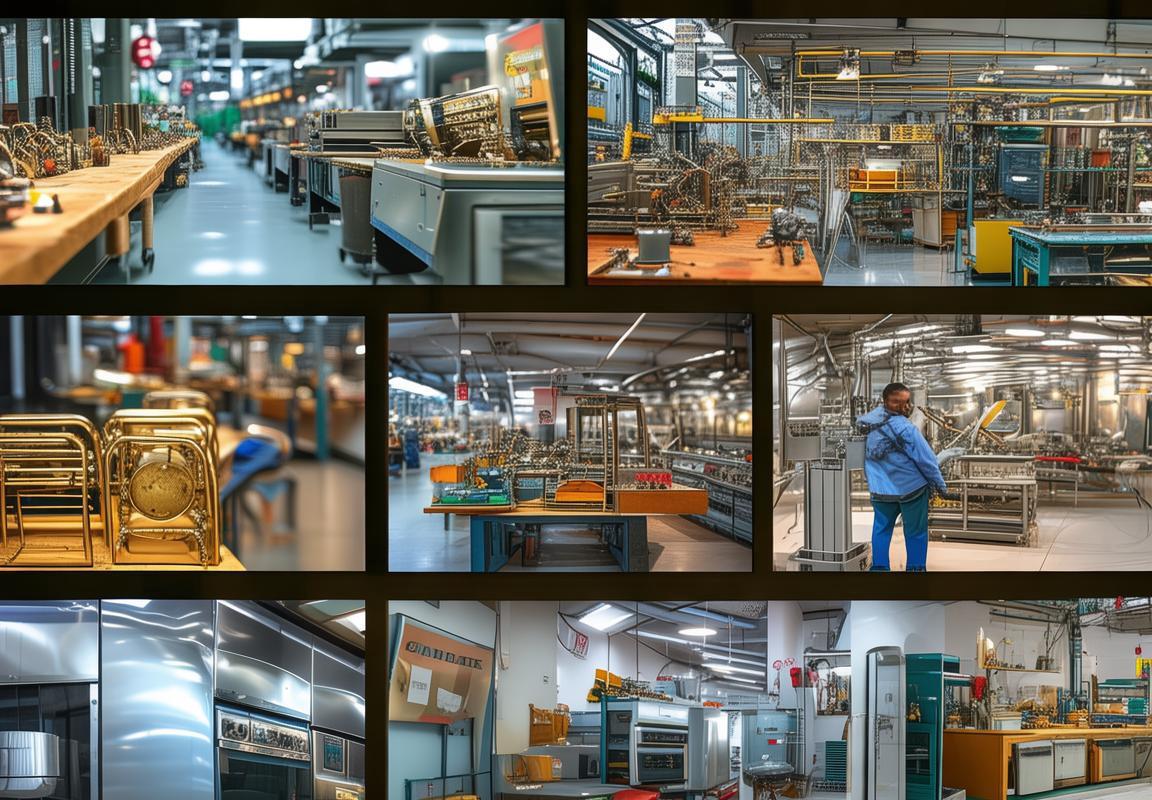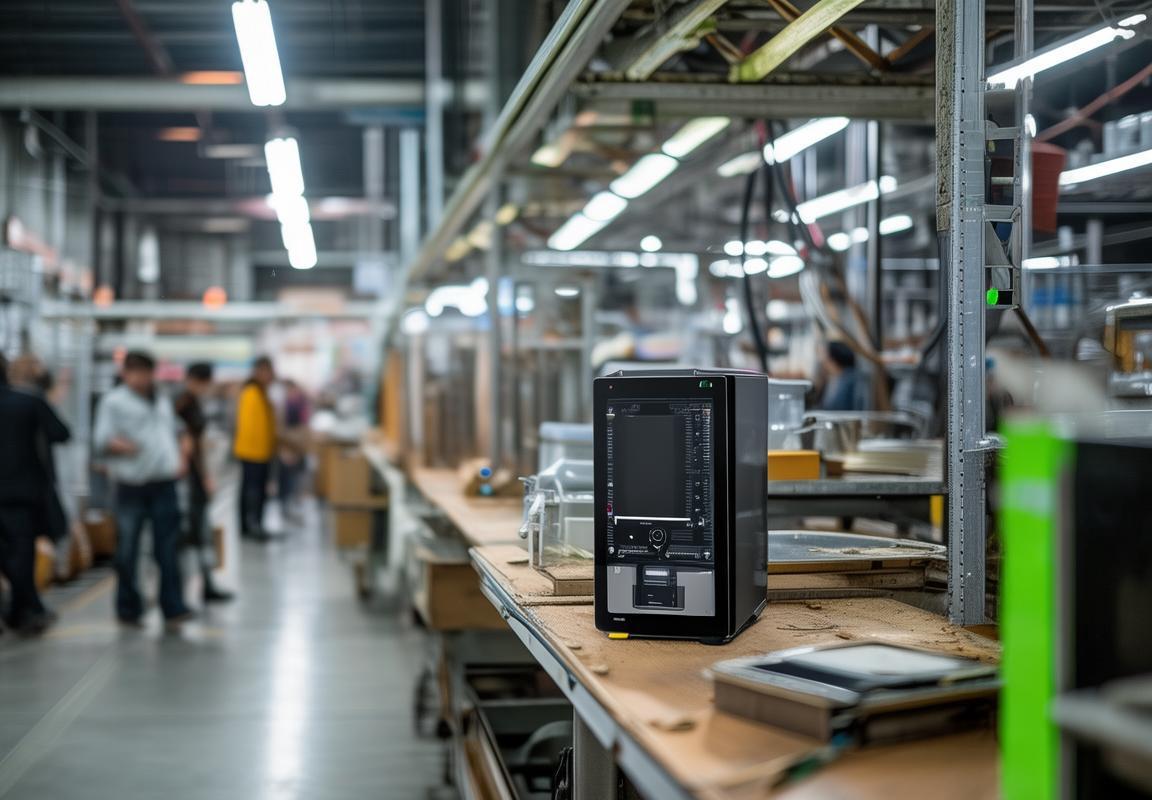In the ever-evolving landscape of the kitchen appliance industry, a significant shift has been observed in recent years. The rise of local suppliers has become a pivotal trend, reshaping market dynamics and consumer preferences across Europe and America. This transformation is not just a response to economic factors but also a testament to the innovation and adaptability of domestic manufacturers. As we delve into the intricacies of this shift, it becomes clear that the future of the kitchen appliance market lies in a delicate balance between local expertise and global competition.
Introduction to the Kitchen Appliance Industry in Europe and America
The kitchen appliance industry in Europe and America has long been a hub of innovation and consumer demand. With a rich tapestry of brands and products, this sector has seen rapid evolution, reflecting the changing lifestyles and culinary trends of these regions. In Europe, where the market is characterized by a blend of traditional and modern designs, appliances often reflect the region’s commitment to sustainability and energy efficiency. Conversely, the American market, known for its diverse demographics, features a wide array of products catering to various cooking styles and preferences.
European consumers have a penchant for sleek, integrated kitchen solutions that blend seamlessly into their homes. From high-end German brands like Miele and Siemens to Italian design icons such as Smeg, the European market is a playground for cutting-edge technology and stylish aesthetics. On the other hand, the American market is marked by its vast array of brands, including giants like Whirlpool and KitchenAid, offering everything from budget-friendly models to premium, feature-rich appliances.
The kitchen appliance industry in Europe and America is not just about the products themselves; it’s a reflection of the broader economic and social landscapes. In Europe, the industry is closely tied to the concept of smart homes, where appliances are not just functional but also connected, offering homeowners a level of convenience and control that was once unimaginable. Smart refrigerators, ovens with built-in cameras, and dishwashers that can be controlled via smartphone apps are becoming increasingly common.
In the United States, the kitchen is often seen as the heart of the home, a gathering place for family and friends. This cultural emphasis on the kitchen has led to a market that values versatility and durability. American consumers are looking for appliances that can handle everything from everyday cooking tasks to elaborate culinary endeavors, and they’re willing to invest in high-quality products that can stand the test of time.
Despite the diversity in the market, there’s a common thread that binds European and American consumers: the desire for quality and reliability. Whether it’s a French stove, a British range, or an American microwave, customers expect their appliances to perform consistently and efficiently. This demand has created a competitive landscape where innovation is key, and brands must constantly strive to improve their offerings.
In recent years, the kitchen appliance industry has also been influenced by global trends, such as the rise of health-conscious cooking and the emphasis on sustainability. Consumers are increasingly interested in appliances that can help them prepare healthier meals and reduce their environmental footprint. This shift has led to the development of appliances with features like programmable cooking modes, non-toxic materials, and energy-saving capabilities.
The European and American markets also differ in terms of distribution channels. In Europe, traditional retailers and department stores remain a significant part of the sales landscape, but online sales are growing rapidly. Conversely, the American market is more fragmented, with a mix of large home improvement chains, specialty appliance stores, and online retailers. This diversity in distribution means that manufacturers must adapt their strategies to meet the unique needs of each channel.
In conclusion, the kitchen appliance industry in Europe and America is a dynamic and complex sector, shaped by a multitude of factors. From the cultural nuances of each region to the evolving consumer preferences and technological advancements, the industry must continuously evolve to stay relevant. Whether it’s through sleek design, smart functionality, or eco-friendly features, the industry is poised to meet the changing demands of today’s consumers.

The Concept of Import Substitution Program
The import substitution program (ISP) is a strategic economic approach aimed at reducing dependence on foreign imports by promoting the development and production of domestically manufactured goods within a country. This concept has been particularly influential in the kitchen appliance industry, where the shift towards local production has been gaining momentum in both Europe and America.
In essence, an ISP involves the replacement of imported goods with locally produced alternatives. This is often driven by a combination of economic, political, and social factors. Economically, it can be a way to stimulate local industries, create jobs, and reduce trade deficits. Politically, it may reflect a desire for national self-sufficiency and sovereignty. Socially, it can be a response to concerns over the quality, safety, and sustainability of imported products.
Historically, import substitution programs were most prevalent in developing countries, where they were used to promote industrialization and reduce reliance on foreign aid. However, in recent years, as global supply chains have become more complex and vulnerable, even developed nations have begun to reconsider the role of local production.
One of the key aspects of an ISP is the identification of goods that are critical to national security or strategic importance. In the kitchen appliance sector, this might include products like refrigerators, dishwashers, and ovens, which are not only essential for daily life but also significant contributors to the energy and water efficiency of homes.
In Europe, where the kitchen appliance industry is highly developed, the concept of import substitution has taken a slightly different form. Rather than a complete ban on imports, European countries have been focusing on creating a competitive environment that fosters the growth of local manufacturers. This includes providing incentives for innovation, investing in research and development, and implementing stringent safety standards.
Similarly, in the United States, import substitution programs have been more targeted. The U.S. government has historically offered subsidies and tax incentives to domestic appliance manufacturers to compete with foreign counterparts. This has been particularly evident in the aftermath of trade disputes and geopolitical tensions that have impacted global supply chains.
The success of an import substitution program in the kitchen appliance industry hinges on several key factors. First, there must be a clear demand for domestically produced appliances. This can be influenced by factors such as consumer preference, cultural identity, and the perceived quality of local products. Second, the domestic industry must be capable of meeting the quality and quantity demands of the market. This requires a robust manufacturing infrastructure, skilled labor, and access to advanced technology.
Another critical element is the presence of supportive government policies. These can include financial assistance, trade barriers, and technical support. In some cases, this might involve the creation of special economic zones or free trade agreements that benefit local manufacturers. Additionally, government initiatives to promote energy efficiency and sustainability can also indirectly support the growth of the local kitchen appliance sector.
Despite the potential benefits, implementing an import substitution program is not without challenges. One of the primary concerns is the risk of higher costs for domestically produced goods. This can lead to higher prices for consumers and, in some cases, reduced competitiveness compared to foreign imports. Moreover, the domestic industry may struggle to match the scale and efficiency of established global suppliers, particularly in the early stages of the program.
Furthermore, there is the issue of innovation and product development. While domestic suppliers may have a better understanding of local consumer needs, they may lack the global perspective and resources to introduce cutting-edge technology and design. This can be mitigated through collaboration with foreign partners or by investing in research and development.
In conclusion, the concept of import substitution program in the kitchen appliance industry is a multifaceted approach that can have significant implications for economic development, market dynamics, and consumer choice. By carefully navigating the challenges and leveraging the opportunities, countries can achieve a balance between local production and global competitiveness.

Factors Driving the Growth of Local Suppliers
The growth of local suppliers in the kitchen appliance industry is a multifaceted phenomenon influenced by a variety of factors. These drivers can be categorized into economic, technological, regulatory, and consumer-oriented aspects.
Economic factors play a significant role in shaping the landscape of local suppliers. One key economic driver is the desire to reduce dependence on foreign imports, which can be expensive and subject to fluctuating exchange rates. Local suppliers often offer more competitive pricing due to lower transportation costs and a better understanding of regional demand patterns. Additionally, the economic downturns have prompted consumers to seek more affordable options, leading to a surge in demand for locally produced appliances.
Technological advancements have democratized the production process, making it more accessible to smaller businesses. The rise of 3D printing and modular manufacturing has allowed local suppliers to create customized and niche products that cater to specific market segments. This technological empowerment has not only reduced the cost barriers to entry but has also enabled these suppliers to innovate and offer products with unique features that larger, multinational corporations may overlook.
Regulatory changes have also been a driving force behind the growth of local suppliers. Many governments in Europe and America have implemented policies aimed at promoting domestic manufacturing and reducing the trade deficit. Tariffs, quotas, and import restrictions have made foreign products more expensive, creating a more favorable environment for local suppliers to thrive. Furthermore, environmental regulations have pushed manufacturers to adopt more sustainable practices, which local suppliers are often better positioned to achieve due to their smaller scale and local sourcing.
Consumer preferences have shifted over time, favoring locally produced goods. Consumers are increasingly valuing the quality, craftsmanship, and ethical practices associated with local suppliers. The “buy local” movement has gained momentum, as consumers recognize the economic and environmental benefits of supporting businesses within their community. This trend is particularly pronounced in the kitchen appliance market, where there is a growing appreciation for appliances that are designed with local materials and have a lower carbon footprint.
Another factor contributing to the growth of local suppliers is the rise of e-commerce. Online platforms have lowered the barriers to market entry for small businesses, allowing them to reach a wider audience without the need for extensive distribution networks. Local suppliers can now compete on a global scale by leveraging digital marketing and direct-to-consumer sales models, which has expanded their market reach and increased sales.
The development of local supply chains has also played a crucial role. By sourcing materials and components locally, suppliers can reduce lead times and improve product quality. This localization of supply chains not only strengthens the local economy but also ensures that suppliers have a better understanding of the materials and manufacturing processes, leading to more efficient and responsive production.
Lastly, the trend towards customization and personalization has fueled the growth of local suppliers. Consumers are looking for appliances that not only meet their functional needs but also reflect their personal style and preferences. Local suppliers can offer tailored solutions that larger manufacturers might not be able to provide due to their standardized production processes.
In conclusion, the growth of local suppliers in the kitchen appliance industry is driven by a combination of economic rationality, technological advancements, regulatory changes, consumer preferences, e-commerce opportunities, the development of local supply chains, and the demand for customized products. These factors have created a fertile ground for local suppliers to flourish and contribute to the diversity and innovation within the industry.

The Impact of Local Suppliers on Market Dynamics
The surge of local suppliers in the kitchen appliance market has injected a dynamic energy into what was once a predominantly globalized industry. This shift has several impacts on the market dynamics, reshaping competition, consumer behavior, and the overall landscape of the sector.
-
Enhanced Competition: The rise of local suppliers has sparked a healthy competition within the market. These domestic players often offer unique designs and specialized solutions that cater to regional preferences, challenging the dominance of international brands. This competition has led to innovation, as both local and international companies strive to differentiate themselves in terms of product features, pricing, and customer service.
-
Price Sensitivity: Local suppliers often benefit from a more favorable cost structure due to proximity to raw materials and lower operational overheads. This allows them to offer competitive pricing, making kitchen appliances more accessible to a broader segment of the population. The increased affordability has not only expanded the market but also influenced consumer purchasing behavior, making price a more significant factor in buying decisions.
-
Customization and Local Trends: Local suppliers have a better understanding of regional tastes and trends, enabling them to develop products that resonate with local consumers. This customization extends beyond just aesthetics to include functionality and usability, which are tailored to the specific needs and habits of the local market. As a result, consumers are more likely to find appliances that perfectly match their lifestyles and preferences.
-
Supply Chain Resilience: One of the most notable impacts of local suppliers is the enhancement of supply chain resilience. In the wake of global supply chain disruptions, having a robust local supply base can be a lifesaver. Local suppliers can respond more quickly to market demands, reduce lead times, and ensure product availability during unforeseen global disruptions.
-
Job Creation and Economic Impact: The growth of local suppliers contributes significantly to job creation within the region. From manufacturing to sales and distribution, these companies create employment opportunities that can stimulate local economies. The ripple effect of this economic activity is often felt beyond the direct employment, influencing local industries and services.
-
Brand Loyalty and National Pride: Local suppliers often foster a sense of brand loyalty among consumers who are proud of supporting domestic businesses. This loyalty can translate into higher repeat purchase rates and positive word-of-mouth referrals. The emphasis on national pride can also lead to a resurgence of regional brands, challenging the long-standing reputation of international giants.
-
Sustainability and Environmental Responsibility: Local suppliers are often more attuned to local environmental concerns and can implement sustainable practices that align with regional regulations and consumer expectations. This focus on sustainability can be a major selling point, especially as consumers become more environmentally conscious and demand eco-friendly products.
-
Market Control and Policy Influence: With the increased presence of local suppliers, there’s a greater balance of power in the market. This shift can lead to a more equitable negotiation of trade policies and regulations, potentially benefiting domestic companies. Local suppliers can also influence government policies, advocating for measures that support their growth and the overall development of the industry.
-
Technological Innovation: The competitive landscape created by local suppliers can drive technological innovation. As they strive to outdo each other, local companies are encouraged to invest in research and development, leading to new technologies and product features that might not have been prioritized by larger, less agile international corporations.
-
Enhanced Market Transparency: Local suppliers typically operate in smaller, more localized markets, which can lead to greater transparency. Consumers may find it easier to understand the source of their appliances, the conditions under which they are produced, and the company’s ethical practices. This transparency can build trust and credibility with consumers who value knowing where their products come from.

Case Studies: Successful Import Substitution in Action
In the realm of kitchen appliance markets, import substitution programs have become a pivotal strategy for many local suppliers. These initiatives aim to reduce dependence on foreign imports by fostering domestic production. Let’s delve into a few case studies that showcase successful import substitution in action.
1. Brazil’s Focus on Domestic ProductionBrazil’s kitchen appliance industry has seen a significant shift towards local suppliers. The government’s import substitution program has encouraged domestic manufacturers to invest in technology and innovation. Companies like Brastemp and Electrolux have expanded their production capabilities, leading to a reduction in imports and a stronger domestic market presence.
2. South Korea’s Electronics Industry GrowthSouth Korea’s success story in the kitchen appliance sector is a testament to the power of import substitution. Once heavily reliant on foreign technology, South Korean companies like LG and Samsung have developed their own manufacturing capabilities. This shift has not only reduced imports but has also propelled the country to become a global leader in electronics, including kitchen appliances.
3. China’s Domestic Appliance PowerhouseChina has emerged as a powerhouse in the kitchen appliance industry, largely due to its import substitution efforts. Local brands like Midea, Haier, and Gree have surged ahead, offering a wide range of products at competitive prices. The government’s support and the shift towards domestic manufacturing have made China a significant player in the global market.
4. Turkey’s Focus on Local ProductionTurkey has been actively promoting local production in the kitchen appliance sector. The country’s import substitution program has led to the growth of domestic manufacturers like Arçelik and Beko. These companies have been able to capture a significant share of the domestic market and have even begun exporting to neighboring countries.
5. India’s Push for Local AppliancesIndia’s kitchen appliance market has seen a surge in domestic suppliers, driven by the import substitution program. Local brands like Whirlpool of India and Bajaj have gained traction by offering affordable and reliable products. The government’s incentives and the push for ‘Make in India’ have played a crucial role in this transformation.
6. Poland’s Domestic Appliance SectorPoland’s kitchen appliance industry has benefited from the import substitution program, with local manufacturers like Amica and Electrolux Poland leading the charge. These companies have been able to tap into the domestic market’s potential, offering a variety of products that cater to local preferences and needs.
7. The Role of Government PoliciesGovernment policies have been instrumental in facilitating the growth of local suppliers. In many cases, these policies include tax incentives, subsidies, and infrastructure development to support domestic manufacturing. These measures have helped to create a more conducive environment for local suppliers to thrive.
8. The Importance of InnovationInnovation has been a key driver in the success of import substitution programs. Local suppliers that have invested in research and development have been able to produce high-quality, innovative products that meet or exceed international standards. This has not only helped to reduce imports but has also positioned these companies as industry leaders.
9. The Consumer PerspectiveConsumers have also played a significant role in the success of import substitution. As local suppliers have improved the quality and variety of their products, consumers have increasingly turned to domestic brands. This shift in consumer preference has further bolstered the growth of local suppliers.
10. The Global ImpactThe success of import substitution programs in various countries has had a global impact. It has sparked a trend towards local production and has forced international brands to reconsider their strategies. This shift has the potential to reshape the global kitchen appliance market, with local suppliers taking a more prominent role.

Challenges and Opportunities for Local Suppliers
In the competitive landscape of the kitchen appliance market, local suppliers face a unique set of challenges and opportunities. Balancing the desire to grow with the need to innovate and meet consumer demands is a delicate dance that requires strategic planning and adaptability.
Navigating Global Supply ChainsLocal suppliers often grapple with the complexities of global supply chains. While they may have the advantage of proximity, they must also contend with fluctuating raw material costs, transportation logistics, and the volatility of international trade. However, this challenge also presents an opportunity to forge stronger, more sustainable relationships with suppliers and reduce dependency on long-distance imports.
Adapting to Technological AdvancementsThe rapid pace of technological innovation can be both a threat and a catalyst for growth. Local suppliers must invest in research and development to keep up with the latest trends, such as smart appliances and energy efficiency. By doing so, they can differentiate their products and appeal to consumers who value cutting-edge technology. This adaptation, however, requires significant capital and expertise, which can be a barrier for some smaller companies.
Meeting Stringent Quality StandardsConsumers in Europe and America have high expectations when it comes to the quality of kitchen appliances. Local suppliers must meet or exceed these standards to gain market share. This means investing in quality control measures, rigorous testing protocols, and certifications that assure customers of the reliability and safety of their products. The opportunity here lies in building a reputation for excellence, which can lead to increased brand loyalty and market demand.
Understanding Consumer PreferencesConsumer preferences are ever-evolving, and local suppliers must stay attuned to these changes. This involves conducting market research, analyzing consumer trends, and aligning product development with these insights. For instance, the rise of eco-conscious consumers has led to a demand for appliances that are energy-efficient and sustainable. Suppliers that can cater to these preferences stand to gain a competitive edge.
Dealing with Regulatory HurdlesRegulatory compliance is a significant challenge for local suppliers, particularly when it comes to safety standards and environmental regulations. Adhering to these laws can be costly and time-consuming. However, for suppliers that navigate these hurdles successfully, there is an opportunity to become trusted partners within the industry. This trust can translate into long-term contracts and partnerships with retailers and manufacturers.
Expanding Distribution ChannelsDistribution is key in the kitchen appliance market. Local suppliers must find effective ways to get their products onto shelves and into homes. This might involve establishing partnerships with major retailers, developing an online presence, or even creating their own distribution networks. The challenge here is to ensure that products are readily available to consumers while also managing the costs associated with distribution.
Building Brand RecognitionBranding is crucial for local suppliers looking to carve out a niche in a crowded market. Creating a strong brand identity that resonates with consumers can be challenging, especially when competing against well-established international brands. However, successful branding can lead to increased visibility, customer trust, and ultimately, higher sales. Suppliers must invest in marketing and advertising to build their brand and communicate the unique value they offer.
Managing Costs and Pricing StrategiesCost management is a constant concern for local suppliers. They must find ways to keep production costs low without compromising on quality. This can involve optimizing manufacturing processes, sourcing materials locally, and negotiating favorable terms with suppliers. When it comes to pricing strategies, suppliers must balance affordability with profitability, ensuring that their products are competitive while also delivering value to the consumer.
Cultivating a Skilled WorkforceThe success of local suppliers hinges on the skills and expertise of their workforce. Investing in employee training and development is essential to maintain high production standards and innovation. Suppliers must also attract and retain talent in a competitive job market. The opportunity here is to create a culture of excellence that drives continuous improvement and fosters a loyal and skilled workforce.
Embracing Sustainable PracticesAs sustainability becomes a more pressing issue, local suppliers have the opportunity to differentiate themselves by adopting environmentally friendly practices. This could include using renewable energy, reducing waste, and manufacturing appliances with recyclable materials. While this may require initial investment, it can lead to a positive brand image and attract customers who prioritize sustainability.
In conclusion, the challenges and opportunities for local suppliers in the kitchen appliance market are multifaceted. By addressing these challenges head-on and capitalizing on the opportunities, local suppliers can not only survive but thrive in a dynamic and competitive global market.

Consumer Preferences and Market Trends
In the dynamic world of kitchen appliances, consumer preferences and market trends are constantly evolving, shaping the landscape for suppliers and manufacturers. Understanding these shifts is crucial for local suppliers looking to thrive in the competitive market. Here’s a delve into the consumer preferences and market trends that are currently shaping the kitchen appliance industry.
The surge in eco-consciousness has led to a significant increase in demand for energy-efficient appliances. Consumers are not only looking for products that save them money on their utility bills but also those that are environmentally friendly. Smart appliances that offer remote monitoring and control to optimize energy use are becoming increasingly popular.
Health and safety concerns are also driving consumer preferences. There’s a growing trend towards appliances that are free from harmful chemicals, such as BPA-free plastic components in kitchenware. Moreover, appliances with advanced safety features, like child locks on ovens and automatic shut-offs in microwaves, are being sought after for their peace of mind.
Technology integration is a major trend that is transforming the kitchen appliance market. Smart kitchen appliances equipped with IoT (Internet of Things) capabilities are becoming more common. These devices allow for seamless integration with other smart home systems, providing users with convenience and the ability to manage their kitchen appliances remotely.
The preference for convenience is undeniable. Consumers are gravitating towards appliances that simplify daily tasks and save time. For instance, multi-functional appliances that can perform multiple tasks—like a fridge that can also defrost and a coffee maker that can grind beans—offer added value and are more appealing than single-purpose devices.
Aesthetic appeal is also a significant factor in consumer preferences. Modern kitchen designs often feature sleek, minimalist lines, and appliances that can complement these aesthetics are in high demand. Stainless steel remains a popular finish, but there’s a growing trend towards colors and finishes that can add a pop of personality to the kitchen.
Customization is another trend that’s gaining traction. Consumers are looking for appliances that can be tailored to their specific needs, whether it’s a particular size to fit a small kitchen or a unique feature that caters to a specific cooking style. This demand is prompting suppliers to offer more personalized options.
Sustainability is a core value for many consumers, and this extends to the kitchen as well. There’s a rising preference for appliances that are made with sustainable materials and that have a longer lifespan, reducing the need for frequent replacements. Recyclable and upgradable components are becoming more common.
The global shift towards plant-based diets has also influenced the kitchen appliance market. There’s an increased interest in appliances that make it easier to prepare plant-based meals, such as high-powered blenders for smoothies and multi-cookers that can handle a variety of cooking methods, including steam and pressure cooking.
Lastly, the importance of brand reputation and customer service cannot be overstated. Consumers are more likely to choose a brand they trust, and excellent customer service can make or break a customer’s experience with a product. Suppliers that prioritize building strong relationships with their customers are likely to see a positive impact on their sales and market share.
As the kitchen appliance industry continues to evolve, suppliers must stay attuned to these consumer preferences and market trends. By offering innovative products that meet these demands, local suppliers can carve out a niche in a market that is ever-changing and increasingly diverse.

Government Policies and Initiatives
In the evolving landscape of the kitchen appliance market, government policies and initiatives play a pivotal role in shaping the industry’s direction. From subsidies and trade agreements to environmental regulations, these factors can significantly impact local suppliers and the overall market dynamics. Here’s an exploration of how various government actions influence the appliance sector.
Economic Incentives and SubsidiesGovernments often provide economic incentives to encourage the growth of local manufacturing. These can come in the form of subsidies, tax breaks, or grants aimed at reducing the cost of production. For instance, in Germany, the federal government has implemented a “High-Tech Strategy” that includes subsidies for research and development in the appliance industry. Such incentives can lower the barriers to entry for new local suppliers and help them compete with international giants.
Trade Agreements and TariffsTrade policies can either boost or hinder the growth of local suppliers. Free trade agreements can open up markets, allowing local companies to export their products at a competitive price. Conversely, tariffs and trade barriers can protect domestic industries, giving local suppliers a competitive edge. For example, the European Union’s Common External Tariff (CET) can impose higher duties on non-EU imports, making locally produced appliances more attractive to consumers.
Environmental RegulationsEnvironmental concerns have become a central focus for governments worldwide. Regulations that require appliances to meet certain energy efficiency standards can drive innovation and favor suppliers that offer eco-friendly products. In the United States, the Energy Star program is a prominent example, which certifies appliances that meet strict energy efficiency criteria. Such certifications can be a major selling point for local suppliers looking to differentiate their products.
Sustainability and Social ResponsibilityGovernments are increasingly pushing for sustainability and social responsibility in business practices. This can manifest through certifications like Fair Trade or through regulations that require companies to adhere to certain labor standards. Local suppliers that can demonstrate their commitment to sustainability may find a niche market among environmentally conscious consumers and businesses.
Innovation and R&D SupportInvestments in research and development (R&D) are crucial for the advancement of any industry. Governments often provide funding or tax incentives for companies to invest in R&D, which can lead to the development of new technologies and products. For instance, the UK government’s Catapult programme supports R&D in various sectors, including kitchen appliances, helping local suppliers to innovate and stay competitive.
Consumer Protection LawsStrong consumer protection laws can protect local suppliers by ensuring fair competition. Regulations that prevent unfair business practices, such as price fixing or misleading advertising, can create a level playing field for all suppliers. In France, the Competition Authority plays a role in ensuring that local and international suppliers adhere to these laws.
Public Procurement PoliciesPublic procurement policies can also impact the kitchen appliance market. Governments often set aside contracts for local suppliers, promoting the growth of domestic industries. In the US, the Buy American Act is an example of such a policy, which requires federal agencies to give preference to domestic suppliers.
Trade Promotion ProgramsGovernments may also run trade promotion programs that help local suppliers to enter new markets. These programs can include export subsidies, market research, and trade missions. By facilitating access to international markets, these programs can significantly boost the growth of local suppliers.
Education and Training ProgramsInvesting in education and training programs can also benefit local suppliers. By providing workers with the skills needed to produce high-quality appliances, governments can enhance the competitiveness of local manufacturers. In Sweden, the government offers vocational training programs that specifically target the appliance industry.
In summary, the role of government policies and initiatives in the kitchen appliance market is multifaceted. While some policies may protect domestic industries, others encourage innovation and sustainable practices. As the market continues to evolve, it’s clear that the interplay between government actions and market dynamics will remain a critical factor in shaping the future of the industry.

Technological Advancements Shaping Local Production
The integration of smart technology has revolutionized the landscape of local kitchen appliance production. From automation to energy efficiency, these advancements have not only improved the quality of products but also opened up new markets and opportunities for local suppliers.
In recent years, there has been a significant push towards energy-saving appliances, driven by both environmental concerns and consumer demand. Local manufacturers have responded by developing a range of products that meet these standards, offering consumers a more sustainable option without compromising on performance. For instance, induction cooktops and LED lighting have become increasingly popular, as they consume less energy and have a longer lifespan.
The rise of connected kitchen appliances has also been a game-changer. Local suppliers have embraced the IoT (Internet of Things) trend, producing smart ovens, refrigerators, and dishwashers that can be controlled remotely via smartphones or tablets. This connectivity not only adds convenience but also allows for predictive maintenance and real-time performance monitoring, which can lead to lower operational costs and increased customer satisfaction.
Another significant technological development is the use of 3D printing in the production process. This technology has enabled local suppliers to create customized kitchen appliances tailored to specific customer needs, reducing waste and inventory costs. It has also allowed for rapid prototyping and shorter production cycles, making it easier for manufacturers to adapt to changing market demands.
Innovation in materials science has also played a crucial role. Local suppliers have started using advanced materials such as stainless steel alloys for durability and corrosion resistance, and bamboo for its eco-friendly and sustainable properties. These materials not only enhance the lifespan of the appliances but also appeal to environmentally conscious consumers.
The implementation of robotics and automation in manufacturing has not only increased efficiency but has also allowed for higher-quality products. With robots handling repetitive tasks, human workers can focus on more complex and precise operations, leading to a decrease in defects and an improvement in overall product quality.
The integration of AI (Artificial Intelligence) and machine learning is another area where local suppliers are making strides. AI-driven predictive analytics can help manufacturers anticipate maintenance needs, optimize production schedules, and even personalize marketing strategies based on consumer behavior data. This level of intelligence can give local suppliers a competitive edge in a market that is becoming increasingly digital and data-driven.
In the realm of design, local suppliers are leveraging technology to create more aesthetically pleasing and user-friendly appliances. From sleeker lines to intuitive interfaces, the focus is on creating products that not only perform well but also look great and are easy to use.
The global shift towards sustainability has also influenced local production. Suppliers are investing in renewable energy sources to power their factories and are exploring circular economy models that focus on recycling and reusing materials. These efforts not only align with global trends but also open up new business opportunities, such as the development of green certifications and eco-labels.
In conclusion, technological advancements are reshaping local production in the kitchen appliance industry. By embracing innovation, local suppliers are not only able to compete with international brands but are also leading the way in sustainability, customization, and consumer satisfaction. As technology continues to evolve, the potential for growth and success in this sector is vast.

Conclusion: The Future of Local Kitchen Appliance Suppliers in the Global Market
The rise of local kitchen appliance suppliers in the global market is not just a trend; it’s a testament to the evolving dynamics of the industry. As we stand at the cusp of a new era, it’s crucial to reflect on the future prospects of these suppliers. From adapting to changing consumer demands to leveraging technological breakthroughs, the path ahead is multifaceted. Here’s a glimpse into the potential future of local kitchen appliance suppliers on the global stage.
The integration of smart technology in kitchen appliances has opened up new avenues for innovation. Suppliers who have embraced these advancements are not only able to offer cutting-edge products but also to stay ahead of the curve in terms of customer expectations. The future lies in the seamless fusion of convenience, efficiency, and connectivity, and local suppliers are well-positioned to lead this transformation.
As sustainability gains more traction, local suppliers are likely to play a pivotal role. With a closer proximity to their markets, these companies can more easily implement green practices and source eco-friendly materials. This focus on sustainability isn’t just a moral imperative; it’s also a market opportunity. Consumers are increasingly seeking appliances that are kind to the environment, and local suppliers can capitalize on this preference.
The rise of e-commerce has democratized access to global markets. Local suppliers can now reach customers across the world with relative ease, bypassing traditional barriers to entry. This expanded reach means that suppliers must focus on branding and customer service, ensuring that their products not only perform well but also leave a lasting impression on buyers.
Global supply chain disruptions have underscored the importance of having a robust local supply network. Local suppliers can offer more flexibility and quicker response times to market changes. This agility is particularly valuable in industries like kitchen appliances where product lifecycles are short and consumer preferences can shift rapidly.
Collaboration with local partners is also a key factor in the future success of local suppliers. By working with local businesses, these suppliers can leverage local expertise, reduce transportation costs, and build a more resilient supply chain. This collaborative approach can lead to the development of unique products that resonate with local markets while also appealing to a global audience.
The competitive landscape is shifting, and local suppliers are increasingly seen as a reliable alternative to their international counterparts. This perception is bolstered by the fact that local suppliers often have a deeper understanding of local regulations and consumer behaviors. This nuanced knowledge can be a significant advantage in navigating complex market environments.
Innovation isn’t just about new products; it’s also about the way products are sold and distributed. Local suppliers are experimenting with direct-to-consumer models, which can reduce costs and increase customer loyalty. This direct engagement allows suppliers to gather valuable feedback and make adjustments quickly, ensuring that their offerings remain relevant and appealing.
The rise of the gig economy and remote work has also had an impact on kitchen appliance usage. As more people are spending more time at home, there’s a growing demand for appliances that cater to a variety of needs, from multi-functional kitchen gadgets to energy-efficient models. Local suppliers can tailor their products to meet these evolving demands, offering solutions that are both practical and stylish.
The future of local kitchen appliance suppliers in the global market is bright, but it’s not without its challenges. Suppliers must continue to innovate, invest in research and development, and adapt to changing market conditions. The key to success lies in a combination of technological sophistication, a strong commitment to sustainability, and a deep understanding of consumer needs.
As the world becomes more interconnected, local suppliers have the opportunity to become global players. By focusing on their strengths, leveraging technological advancements, and embracing the opportunities presented by a changing market landscape, these suppliers can look forward to a future where their products are not just available worldwide but also cherished for their quality and innovation. The future of local kitchen appliance suppliers is a story of adaptability, resilience, and the relentless pursuit of excellence.